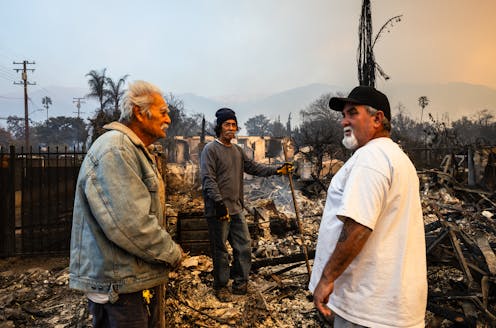How California can rebuild safer, more resilient cities after wildfires without pricing out workers
- Written by Nichole Wissman, Assistant Professor of Management, University of San Diego

The dramatic images of wealthy neighborhoods burning during the January 2025 Los Angeles wildfires captured global attention, but the damage was much more widespread. Many working-class families lost their homes[1], businesses and jobs[2]. In all, more than 16,000 structures[3] – most of them homes – were destroyed, leaving thousands of people displaced.
The shock of this catastrophic loss has been reverberating across Southern California, driving up demand for rental homes and prices[4] in an already unaffordable and competitive housing market[5]. Many residents now face rebuilding costs that are expected to skyrocket.
Climate-related disasters like this often have deep roots in policies and practices that overlook growing risks[6]. In the Los Angeles area, those risks are now impossible to ignore.
As the region starts to recover, communities have an opportunity to rebuild in better ways that can protect neighborhoods against a riskier future – but at the same time don’t price out low-income residents[7].
Research shows that low-income residents struggle the most during and after a disaster[9]. Disaster assistance[10] also tends to benefit the wealthy, who may have more time and resources to navigate the paperwork and process[11]. This can have long-term effects on inequality in a community. In Los Angeles County, where one-third of even moderate-income households spend at least half their income on housing[12], many residents may simply be unable to recover.
My research at the University of San Diego focuses on managing risk in the face of climate change[13]. I see several ways to design solutions that help low- and moderate-income residents recover while building a safer community for the future.
Better building policies that recognize future risk
Before a disaster, communities trying to adapt to climate change often prioritize protecting high-risk, high-value property[14], such as a beachfront or hillside neighborhood with wealthy homes. My own research also shows a trend toward incremental climate adaptations[15] that don’t disturb the status quo too much and, as a result, leave many risks unaddressed.
Climate risks are often underestimated[16], in part because of policy limitations and a political reluctance[17] to consider unpopular solutions, such as restricting where people can build. Yet, disasters once considered unimaginable, such as the Los Angeles wildfires, are occurring with increasing frequency.
Making communities safer from these risks requires communitywide efforts. And that can mean making difficult decisions.
Policy changes, such as updating zoning laws[19] to prevent rebuilding in highly vulnerable areas, can avoid costly damage in the future. So can not building in risky areas in the first place[20].
California already has some of the strictest wildfire-prevention codes in the country, but the same rules for new homes don’t apply to older homes. Communities can invest in programs to help these property owners retrofit their homes by offering grants or incentives to remove highly flammable landscaping[21] or to “harden” existing homes to make them less vulnerable to burning.
Research shows that resilience efforts can spur “climate gentrification[22],” or displacement due to increases in property values. So, focusing on affordability in resilience efforts[23] is important. For long-term affordability and resilience, governments can collaborate with communities to develop strategies such as supporting Community Land Trusts[24] through grants, low-interest loans or land transfers; implementing zoning reforms[25] to enable higher-density, climate-resilient affordable housing; and incentivizing green infrastructure[26] to strengthen community resilience.

